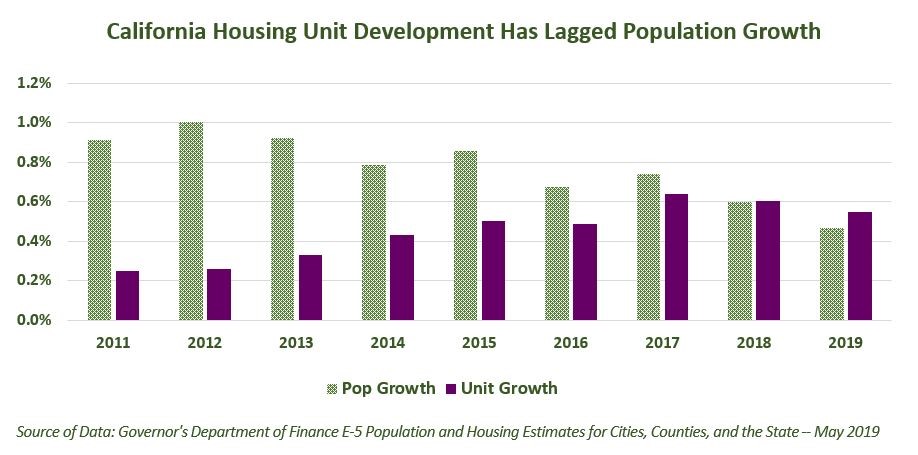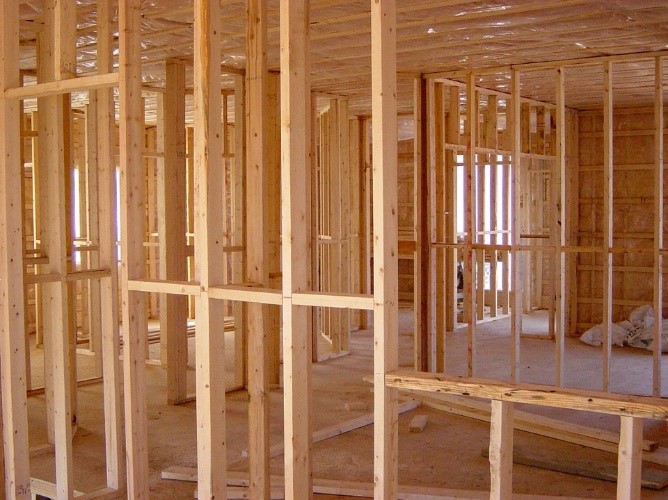You can also view this newsletter as a PDF.

Elevating Our Ambition to
Confront California’s Housing Needs
California is in a housing crisis. For decades, the state has failed to spur enough housing development to accommodate our growing population. Between 2015 and 2025, the state identified an annual housing need of 180,000 units, yet California has produced less than half of that number each year since the goal was set.
 Every year of underproduction exacerbates the state’s housing shortage. The last time California surpassed this 180,000-unit target was in 2005. California is in this predicament due to systemic barriers to development that have become more entrenched over time—ranging from residents’ opposition to new neighbors, neighborhood resistance to degrading “community character,” local actions that delay projects and increase costs, and a tax structure that limits funds available for increased public services. As a result, housing expense has outpaced wages, with cost increases of 35 percent exceeding the 20 percent in wage growth since 2014.
Every year of underproduction exacerbates the state’s housing shortage. The last time California surpassed this 180,000-unit target was in 2005. California is in this predicament due to systemic barriers to development that have become more entrenched over time—ranging from residents’ opposition to new neighbors, neighborhood resistance to degrading “community character,” local actions that delay projects and increase costs, and a tax structure that limits funds available for increased public services. As a result, housing expense has outpaced wages, with cost increases of 35 percent exceeding the 20 percent in wage growth since 2014.
Housing is the defining affordability issue facing California, posing significant risks to the state’s long-term diversity and vibrancy. In fact, notable shifts in the state’s demography are already happening. 2018 saw the state’s slowest population growth in recorded history, as Californians migrate to other states and fewer immigrants come to California. If the status quo continues, the state may face a future without the diverse workforce that fuels economic success.
Companies are eager to grow their operations but are limited by the availability of workers who can afford to live near these jobs. These risks grow in the face of a looming recession. If policymakers do not act in a stable economy to address our housing challenges, housing costs could continue to rise even amidst lay-offs and furloughs. With less revenue to spend on important state programs, policymakers will be confronted with difficult choices between housing assistance and other critical social safety net services.
The convergence of the governor and the legislature prioritizing housing – as well as the availability of budget resources, bond proceeds, and expanded tax credits – presents a significant opportunity to enact real, meaningful solutions to the housing crisis.

Why a Housing Package
Typically, the state’s role has been limited to subsidizing affordable projects and offering local governments tools to spur development, but this role has not been enough to tackle the crisis. The governor’s proposed Fiscal Year 2019-20 State Budget identifies a statewide housing need of 200,000 units annually, and the Governor set an ambitious goal of building 3.5 million homes by 2025. However, the state’s largest housing production program, the Low-Income Housing Tax Credit (LIHTC), supported less than 18,000 units over each of the last five years. Investment in affordable housing is critical, but not sufficient.
To increase supply and lower costs, solutions must target the root of the issue by increasing zoning capacity, establishing statewide housing standards, and establishing adequate tenant protections. The inclusion of significant housing funding in the upcoming budget by the governor and the legislature is laudable. As the enactment of the 2019-20 budget approaches, we must consider what other structural changes are necessary to ensure these investments of taxpayer dollars bear fruit. The budget is an important step, but not the last on the road to meaningful housing reform.
Beyond Individual Proposals and Business as Usual
Housing markets are complex. So are the sedimentary policies layered on top of the problem over time. Enacting a comprehensive package of housing bills is necessary to provide a meaningful response and minimize unintended consequences. For example, major increases in zoning capacity are needed if we are to meet the rising demand.
Statewide zoning standards will eliminate some barriers and allow the market to settle into higher supply and lower prices over time. However, these policies will affect local communities in the short-term, and adequate tenant protections must be in place to prevent displacement. Even among the tenant protection proposals, a complete response is needed so that any benefits of rent stabilization measures are not undone by a lack of eviction protections.
This year has seen record high numbers of housing bills introduced in the legislature, proposing innovative and creative solutions. Together, these ideas have the potential to break down some of the barriers to development that have built up over time.
This legislative session holds great promise for bold solutions, but diligence is needed to organize individual ideas into a cohesive strategy. Policymakers should identify priorities and a framework for achieving shared goals. This work is difficult, both in terms of policy and politics – but California must rise to the challenge and change course from business as usual. Financial resources are robust yet still fall short of meeting the state’s housing demands. It is time to elevate the ambition of our policies to help meet these challenges.
 A Housing Framework
A Housing Framework
California’s housing crisis is multi-faceted, and addressing it requires a clear framework. A housing legislative package should contain the following components:
Expanded Zoning Capacity. In order to build more housing units across the state, there must be sufficient sites zoned for housing development. Local governments are required to zone enough housing to meet their identified housing need. However, not every site zoned for housing is likely to be built to capacity due to the various barriers to development.
To have any chance at meeting more ambitious housing targets, significant zoning changes must be made, such as those proposed in Senate Bill 50 (Wiener). SB 50 allows for housing units to be built to support the economy and the environment. SB 50 would increase zoning capacity in priority areas near transit and jobs and eliminate low-density, single-family zoning across the state. Parking requirements would be reduced in certain areas, lowering the cost of building housing and encouraging the use of nearby public transit.
This bill takes an equitable approach, as SB 50 does not allow the demolition of existing rental housing or designated historic buildings. In addition, sensitive low-income communities would have an additional five years to develop plans to determine zoning changes that comply with SB 50. Voters support these kind of major interventions: a June Public Policy Institute of California poll showed 62 percent of Californians favor less restrictive zoning requirements.
These major zoning changes should be the cornerstone of a comprehensive housing package. Anything less will not be enough to confront our housing crisis. In addition, cities should be required to plan for increased zoning capacity beyond identified housing need. If there is not enough construction in certain areas, statewide zoning standards should come into effect to encourage development.
Statewide Housing Standards. The state should lead with universal policies to coordinate its 500 localities. Universal housing goals should be set that remove subjectivity and local politics. Regulatory and fiscal incentives can reward jurisdictions that see adequate housing growth.
The state also can eliminate some of the forces that prevent development, such as frivolous “NIMBY” lawsuits and excessive fees. Oversight also can be provided through enhanced enforcement of existing housing laws, as well as an avenue for reconsideration of permit denials, such as a state appeals board. A reduction in the cost and time to develop housing will allow more housing of all types to be built in the state.
 Tenant Protections. With housing supply and demand being so far out of sync, low-income renter households face risks of displacement, discrimination, and eviction. Policies are desperately needed to boost supply and alleviate pressure on the market. Policies to expand zoning capacity and implement statewide housing standards will address the supply imbalance in the long-term but may pose more immediate displacement concerns in some neighborhoods.
Tenant Protections. With housing supply and demand being so far out of sync, low-income renter households face risks of displacement, discrimination, and eviction. Policies are desperately needed to boost supply and alleviate pressure on the market. Policies to expand zoning capacity and implement statewide housing standards will address the supply imbalance in the long-term but may pose more immediate displacement concerns in some neighborhoods.
Meaningful protections are needed to safeguard tenants until the housing market stabilizes after these production initiatives take hold. Tenant protection policies include rent stabilization, eviction protections, rental subsidies, and prohibitions on source-of-income discrimination.
Dedicated Funding. California must appropriately prioritize the housing crisis in the state budget. A funding commitment is important to support the local governments who must tackle this issue. Further, a continuing source of funds allows for developers to plan a pipeline of projects into the future. The state can commit to ongoing funding through LIHTC or the Multifamily Housing Program. This funding should be provided as flexible housing money to allow for increased production and targeted allocations when necessary.
State Housing Coordination. The state must look internally to ensure the government is doing everything possible to boost production in operations and investments. California should prioritize production, rather than other ancillary goals, with housing investments. The state should evaluate the organization of its housing entities and improve their processes to streamline the distribution of state funds. Investments must be analyzed and funding decisions should be data-driven to maximize units created with taxpayer funds moving forward.
Labor Supply and Building Cost Considerations. The supply of labor is a major impediment to increased housing development, even at current production levels. The lack of labor slows projects, prevents developments from moving forward, and increases costs. Solutions are needed but seldom discussed. One option is to expand apprenticeship programs for residential development by dedicating workforce funds to this priority area. Another option is working with labor and development stakeholders to find a middle ground that provides quality employment and increases the level of production.
Need for Quick Action
A comprehensive housing legislative package centered on significant zoning policy changes must move forward as quickly as possible. Policymakers must continue to build coalitions of support for such a package and enact it. California may be the home of the fifth largest economy in the world, but it is also the home of growing inequality. Swift, bold, and innovative solutions to the state’s housing crisis are critical to the health of our economy and the vibrancy and diversity of our state and communities.